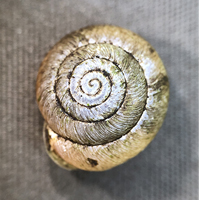Shagreen
Scientific name: Inflectarius inflectus

Photo credit: Samuel Brinkler CC BY-NC 4.0
Status
Endangered
Endangered
means the species lives in the wild in Ontario but is facing imminent extinction or extirpation.
Date added to the Species at Risk in Ontario List
January 26, 2022
Read the assessment report (PDF)
What it looks like
Shagreen is a medium-sized land snail. The shell of an adult member of the species has a width of about 1 cm. Individuals are yellow to brown in colour. The Shagreen’s shell lacks a hole in the middle where the whorls come together and has three tooth-like denticles in the shell opening.
Where it lives
Shagreen occurs in moist forest habitats where it can be found in leaf litter, on logs and exposed rocks. The global distribution of Shagreen extends from southern Ontario, Michigan and New York south to Texas and Florida.
Where it’s been found in Ontario
Shagreen is part of the unique fauna of the Carolinian Forest. In Ontario, the species has a small range. It is currently only known to occur on two Lake Erie islands, Pelee Island and Middle Island.
What threatens it
As a terrestrial snail, Shagreen is susceptible to droughts and flooding on both Pelee and Middle Islands, caused by climate change and strong weather patterns on the Lake Erie shoreline. Additional threats include a decline in habitat quality due to invasive species such as earthworms and the use of prescribed burns to maintain grassland habitats on parts of Pelee Island.
Action we are taking
Endangered species and their habitat are protected under Ontario’s Endangered Species Act, 2007.
Recovery strategy
A recovery strategy advises the ministry on ways to ensure healthy numbers of the species return to Ontario.
Read the executive summary and the full document (January 25, 2023).
Government response statement
A government response statement outlines the actions the government intends to take or support to help recover the species.
Read the government response statement (October 25, 2023)
What you can do
Report a sighting
Submit your observations of species at risk to the Natural Heritage Information Centre (NHIC), which is Ontario’s conservation data centre. Join the (NHIC) Rare Species of Ontario
project in iNaturalist to make submitting your observations quick and easy.
Volunteer
Volunteer with species at risk programs, such as community science surveys, through your local nature club, a provincial park or other conservation organizations.
Be a good steward
- Individuals, communities and organizations across the province who undertake stewardship or research activities that benefit species at risk and their habitats may be eligible to receive funding through the Species at Risk Stewardship Program (SARSP). The SARSP was created to encourage people to get involved in protecting and recovering species at risk in Ontario through stewardship actions.
- Invasive species seriously threaten many of Ontario’s species at risk. To learn what you can do to help reduce the threat of invasive species, visit:
Report illegal activity
Report any illegal activity related to species at risk to
Quick facts
- Shagreen is an egg-laying land snail.
- Individuals may live 1 to 2 years.
- The species feeds mainly on decaying wood and fungi in forest floor litter.
- The only population of Shagreen in Canada occurs in southern Ontario.